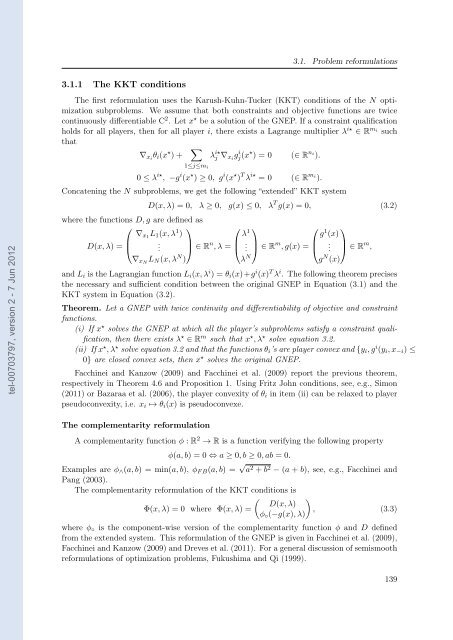Etude des marchés d'assurance non-vie à l'aide d'équilibres de ...
Etude des marchés d'assurance non-vie à l'aide d'équilibres de ...
Etude des marchés d'assurance non-vie à l'aide d'équilibres de ...
You also want an ePaper? Increase the reach of your titles
YUMPU automatically turns print PDFs into web optimized ePapers that Google loves.
tel-00703797, version 2 - 7 Jun 2012<br />
3.1.1 The KKT conditions<br />
3.1. Problem reformulations<br />
The first reformulation uses the Karush-Kuhn-Tucker (KKT) conditions of the N optimization<br />
subproblems. We assume that both constraints and objective functions are twice<br />
continuously differentiable C 2 . Let x ⋆ be a solution of the GNEP. If a constraint qualification<br />
holds for all players, then for all player i, there exists a Lagrange multiplier λ i⋆ ∈ R mi such<br />
that<br />
∇xi θi(x ⋆ ) + <br />
1≤j≤mi<br />
λ i⋆<br />
j ∇xi gi j(x ⋆ ) = 0 (∈ R ni ).<br />
0 ≤ λ i⋆ , −g i (x ⋆ ) ≥ 0, g i (x ⋆ ) T λ i⋆ = 0 (∈ R mi ).<br />
Concatening the N subproblems, we get the following “exten<strong>de</strong>d” KKT system<br />
D(x, λ) = 0, λ ≥ 0, g(x) ≤ 0, λ T g(x) = 0, (3.2)<br />
where the functions D, g are <strong>de</strong>fined as<br />
⎛<br />
∇x1<br />
⎜<br />
D(x, λ) = ⎝<br />
L1(x, λ1 )<br />
.<br />
∇xN LN(x, λN ⎞<br />
⎟<br />
⎠ ∈ R<br />
)<br />
n ⎛<br />
λ<br />
⎜<br />
, λ = ⎝<br />
1<br />
.<br />
λN ⎞<br />
⎟<br />
⎠ ∈ R m ⎛<br />
g<br />
⎜<br />
, g(x) = ⎝<br />
1 (x)<br />
.<br />
gN ⎞<br />
⎟<br />
⎠ ∈ R<br />
(x)<br />
m ,<br />
and Li is the Lagrangian function Li(x, λ i ) = θi(x)+g i (x) T λ i . The following theorem precises<br />
the necessary and sufficient condition between the original GNEP in Equation (3.1) and the<br />
KKT system in Equation (3.2).<br />
Theorem. Let a GNEP with twice continuity and differentiability of objective and constraint<br />
functions.<br />
(i) If x ⋆ solves the GNEP at which all the player’s subproblems satisfy a constraint qualification,<br />
then there exists λ ⋆ ∈ R m such that x ⋆ , λ ⋆ solve equation 3.2.<br />
(ii) If x ⋆ , λ ⋆ solve equation 3.2 and that the functions θi’s are player convex and {yi, g i (yi, x−i) ≤<br />
0} are closed convex sets, then x ⋆ solves the original GNEP.<br />
Facchinei and Kanzow (2009) and Facchinei et al. (2009) report the previous theorem,<br />
respectively in Theorem 4.6 and Proposition 1. Using Fritz John conditions, see, e.g., Simon<br />
(2011) or Bazaraa et al. (2006), the player convexity of θi in item (ii) can be relaxed to player<br />
pseudoconvexity, i.e. xi ↦→ θi(x) is pseudoconvexe.<br />
The complementarity reformulation<br />
A complementarity function φ : R 2 → R is a function verifying the following property<br />
φ(a, b) = 0 ⇔ a ≥ 0, b ≥ 0, ab = 0.<br />
Examples are φ∧(a, b) = min(a, b), φF B(a, b) = √ a 2 + b 2 − (a + b), see, e.g., Facchinei and<br />
Pang (2003).<br />
The complementarity reformulation of the KKT conditions is<br />
<br />
D(x, λ)<br />
Φ(x, λ) = 0 where Φ(x, λ) =<br />
, (3.3)<br />
φ◦(−g(x), λ)<br />
where φ◦ is the component-wise version of the complementarity function φ and D <strong>de</strong>fined<br />
from the exten<strong>de</strong>d system. This reformulation of the GNEP is given in Facchinei et al. (2009),<br />
Facchinei and Kanzow (2009) and Dreves et al. (2011). For a general discussion of semismooth<br />
reformulations of optimization problems, Fukushima and Qi (1999).<br />
139
















